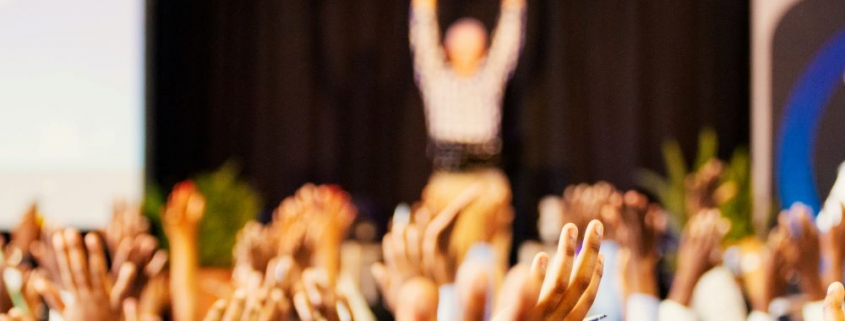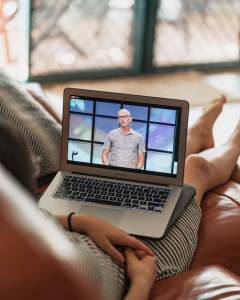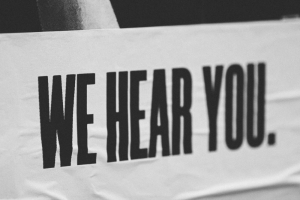How to increase engagement during your events
Whether you’re hosting a conference, an exhibition, or a team meeting, you likely want your participants to be engaged in the event. Long gone are the days when people were religiously listening to a speaker at a lectern. Nowadays, people get distracted by their phones as much as they want to get involved in the discussion.
As the ultimate way to determine value, satisfaction, and the likelihood that the participants will come back, engagement is indeed a priority for 80% of event professionals, according to a study by Bizzabo.
So how do you get people to engage? The answer seems to be to make the event personal to them and make them part of the event, actors, not just spectators.
In this article, we are going to share some tips to help create or increase engagement for all your events.
Get to know your audience and communicate with them
By researching your audience, you can discover the subjects they are most interested in and determine their level of knowledge on these subjects. This will allow you to cater your content to their needs. You also need to communicate opportunities for participation, as letting them discover these things by themselves only wastes everyone’s time.
Photo by Melanie Deziel on Unsplash
How you can implement this:
- Research your audience thoroughly beforehand. Define your target persona and analyze how to structure your narrative around it by using data from past events, the guest list, your audience demographics, etc.
- Create engagement opportunities for your guests: these opportunities can be exclusive content (an interview with a key speaker, for example), advice and instructions (like downloading the app), or exclusive offers (i.e., found on the app or provided in exchange for a given action like answering polls). Help them take advantage of all the possibilities by sending regular emails detailing what’s available to them.
- Create and share content that invites discussion. This should help fuel interest in the upcoming event. Don’t hesitate to partner with sponsors or exhibitors to create that content.
- Engage as much as possible on social media: before the event starts, build social media groups on Facebook or LinkedIn to create a sense of belonging to a community.
- Build anticipation: share snippets of what’s to come and use all the channels available to you: it could be a quick guide on the host city that you email to your list, regular posts on Facebook and Twitter to show pictures of the venue you’ve booked, etc.
Up your social media game
Social media platforms have become the preferred tools for engagement as they are now omnipresent in people’s lives. They allow people to connect, share and discuss issues. In addition, you can use them at all stages of an event.
Photo by Camilo Jimenez on Unsplash
How you can implement this:
- Choose your platforms wisely: according to Skift Meetings, 57% of event planners name Facebook as the best social platform to build a community and for year-round engagement, followed by LinkedIn (25%), Twitter (7%), and Instagram (7%). Facebook allows for more personal relations with your audience and is probably the most wide-reaching platform, while LinkedIn is more dedicated to professional networking.
- Before the event: create an event hashtag and promote it to your attendees, sponsors, exhibitors, speakers, etc.; create a social media group on Facebook and LinkedIn to build a sense of community where your followers can interact; publish all relevant announcements: name of the speakers, programmed sessions, etc.
- During the event: Live stream and/or live tweet so that your virtual audience gets engaged too; create social media walls to showcase relevant posts by the attendees; publish video testimonials or short interviews of attendees, speakers, or exhibitors on Facebook and YouTube; engage with people who are commenting on the event on Twitter and Facebook.
- After the event: share pictures and highlights from the event on Facebook and Instagram; continue to be present in your social media groups communities; offer opportunities for speakers and presenters to create relevant content and promote it on your social media.
Live stream
Live streaming used to matter only when you were hosting meetings with international teams or conferences so that remote participants could get the same level of information.
In a post-COVID world, with a large part of the audience still unable or unwilling to travel and attend in person, offering a live stream option is even more essential.
Photo by Tye Doring on Unsplash
How you can implement this:
- Share slides and audio of the presentations to give your attendees an interactive experience in real time.
- Use message boards to broadcast questions, comments, and reactions. Ideally, your virtual audience should be able to participate as much as your physical one.
Use gamification to add fun
Gamification can be a powerful tool when it comes to incentivizing participation and driving engagement. It works by rewarding people for the desired behavior and structuring that behavior in a way that feels like a game. It’s about fun and connecting and is very effective if done correctly.
How you can implement this:
- Use QR codes involving interactions with exhibitors or sponsors that you can disseminate in the event space for a scavenger hunt.
- Involve exhibitors and sponsors and ask them to contribute prizes (for example, a private session with an expert or a free trial).
- Reward participation by giving points for performing activities, then turning these points into prizes.
- Offer small and major challenges so that everyone can compete, get a prize and engage.
- Highlight the most active engagers by using a leaderboard.
Don’t be afraid to use polls and surveys
Polls and surveys are an excellent opportunity for you to engage your audience by showing them you care about what they think and turning them from passive to active participants.
Surveys will also provide qualitative feedback that gives context to all the data you can collect for the event.
When done live, polls and surveys provide real-time feedback, allowing you to react and make corrections immediately.
Photo by Jon Tyson on Unsplash
How you can implement this:
- Use short surveys throughout the event (instead of a massive after-event survey that nobody has time to complete) that allow you to do quick checks during the event and establish trends.
- Put questions to the vote to ensure the most important topics to your audience are covered. Use your event app to allow participants to submit and vote on questions.
- Incentivize participation: reward your attendees with points (that they can redeem for prizes at the end of the event) whenever they answer a poll.
Use a mobile event app
There are several engagement tools that can be available through event apps: in-app messaging (engagement between attendees), push notifications (engagement between attendees and organizers), live streams, polls and session reviews, gamification, etc.
The app can help attendees find and communicate with like-minded people, making valuable connections in the process. After all, networking is usually people’s number one priority when they attend professional events.
You can also use these apps for smart matchmaking with exhibitors at a tradeshow, therefore increasing the rate of meaningful connections between exhibitors and qualified attendees, which ultimately helps with engagement ROI.
Photo by Rami Al-zayat on Unsplash
How you can implement this:
- Choose a feature-rich event app with the following features: quick to set up, easy to use, with a brandable user interface, integrated engagement features, and analytics to measure ROI.
- Increase your app adoption: communicate with your attendees regarding the existence of the app as soon as they register and give them incentives to use it (like access to exclusive content).
In conclusion
Getting people engaged during events is the holy grail for most event planners but is also usually a challenge due to the many distractions our modern world provides. As a result, competition for attendees’ time and attention is at an all-time high, and event professionals must work harder than before to increase that engagement.
But, as we’ve seen, all is not lost as there are several tools and techniques available to elevate the attendee’s experience and get them more involved.Totm exposition can help you make your tradeshow booths steal the show and get visitors more engaged. Contact us if you have a project you would like to discuss!









